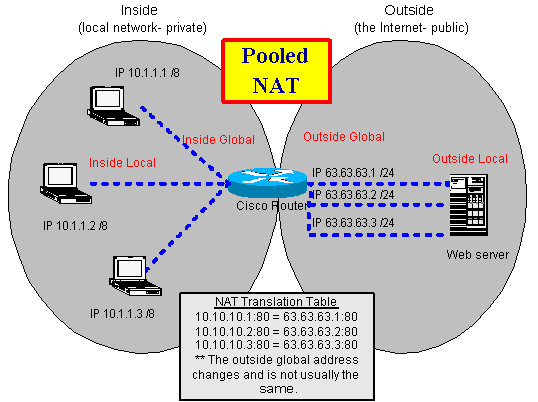This Network Address Translation (NAT) information applies only to On Premise instances of Kerauno and not to be used with Kerauno Hosted instances.
Purpose of NAT
NAT is a feature that allows the IP network of an organization to appear from the outside to use a different IP address space than what it is actually using. Thus, NAT allows an organization with non-globally routable addresses to connect to the Internet by translating those addresses into a globally routable address space. NAT also allows a graceful renumbering strategy for organizations that are changing service providers or voluntarily renumbering into classless interdomain routing (CIDR) blocks. NAT is described in RFC 1631.
Beginning with Cisco IOS Release 12.1(5)T, NAT supports all H.225 and H.245 message types, including FastConnect and Alerting as part of the H.323 Version 2 specification. Any product that makes use of these message types will be able to pass through a Cisco IOS NAT configuration without any static configuration. Full support for NetMeeting Directory (Internet Locator Service) is also provided through Cisco IOS NAT. (Purpose of NAT. (December 18, 2011). IP Addressing: NAT Configuration Guide, Cisco IOS Release 12.4T. Retrieved July 03, 2018, from https://www.cisco.com/c/en/us/td/docs/ios-xml/ios/ipaddr_nat/configuration/12-4t/nat-12-4t-book/iadnat-addr-consv.html.)
How NAT Works
A router configured with NAT will have at least one interface to the inside network and one to the outside network. In a typical environment, NAT is configured at the exit router between a stub domain and the backbone. When a packet leaves the domain, NAT translates the locally significant source address into a globally unique address. When a packet enters the domain, NAT translates the globally unique destination address into a local address. If more than one exit point exists, each NAT must have the same translation table. If NAT cannot allocate an address because it has run out of addresses, it drops the packet and sends an Internet Control Message Protocol (ICMP) host unreachable packet. (How NAT Works. (December 18, 2011). IP Addressing: NAT Configuration Guide, Cisco IOS Release 12.4T. Retrieved July 03, 2018, from https://www.cisco.com/c/en/us/td/docs/ios-xml/ios/ipaddr_nat/configuration/12-4t/nat-12-4t-book/iadnat-addr-consv.html.)
Pooled NAT
Pooled NAT is similar to Port Address Translation (PAT) except you have the luxury of having a one-to-one mapping of addresses. In other words, you have just as many inside network clients as you do outside network IP addresses. You tell the NAT router the pool of IP addresses that are available, and each client receives its own IP addresses when it requests a NAT translation. The client does not get the same address each time it requests a translation; it merely gets the next available address from the pool. Figure 01 below is an illustration of a pooled NAT.
 Figure 01: Pooled NAT Illustration
Figure 01: Pooled NAT Illustration
(Davis, David CCIE. "Pooled NAT". May 14, 2002. TechRepublic Website. Web. Retrieved July 03, 2018. Site: https://www.techrepublic.com/article/set-up-port-address-translation-pat-in-the-cisco-ios/.)
Static NAT
Static NAT is the simplest form of NAT. The most likely example is a mail server on the inside of a private network. The private network connects to the public Internet. In between the two networks, a router performs NAT. For a dedicated server, like a mail server, you would want a static (not changing) IP address. This way, every time someone on the Internet sends email to the mail server, that server has the same public IP address. Refer to Figure 02 below for an illustration of a Static NAT.
 Figure 02: Static NAT Illustration
Figure 02: Static NAT Illustration
(Davis, David CCIE. "Pooled NAT". May 14, 2002. TechRepublic Website. Web. Retrieved July 03, 2018. Site: https://www.techrepublic.com/article/set-up-port-address-translation-pat-in-the-cisco-ios/.)
The NAT Settings panel for Kerauno is illustrated in Figure 03 below.
 Figure 03: Kerauno NAT Settings Panel
Figure 03: Kerauno NAT Settings Panel
If you need more information or support please contact Kerauno Customer Care at 1-800-411-2942.
